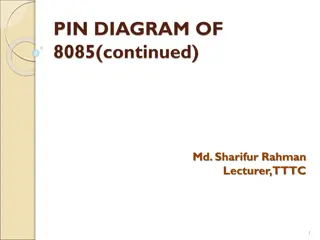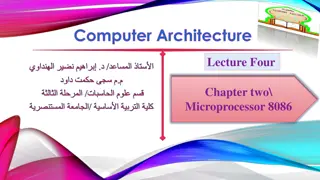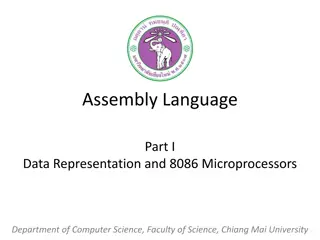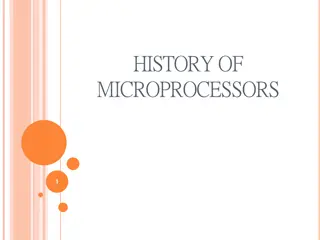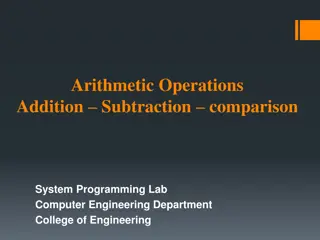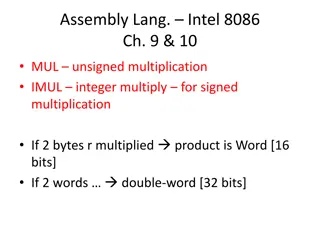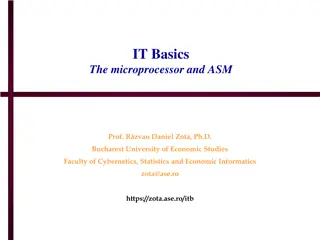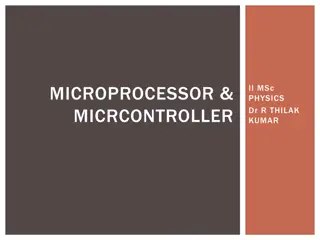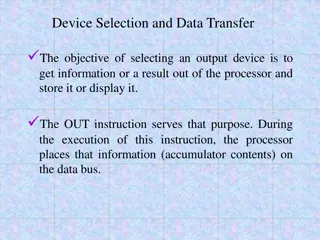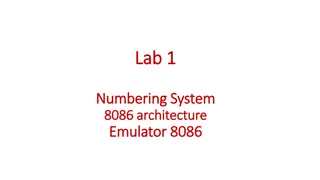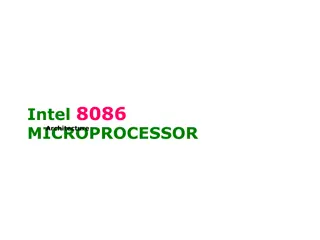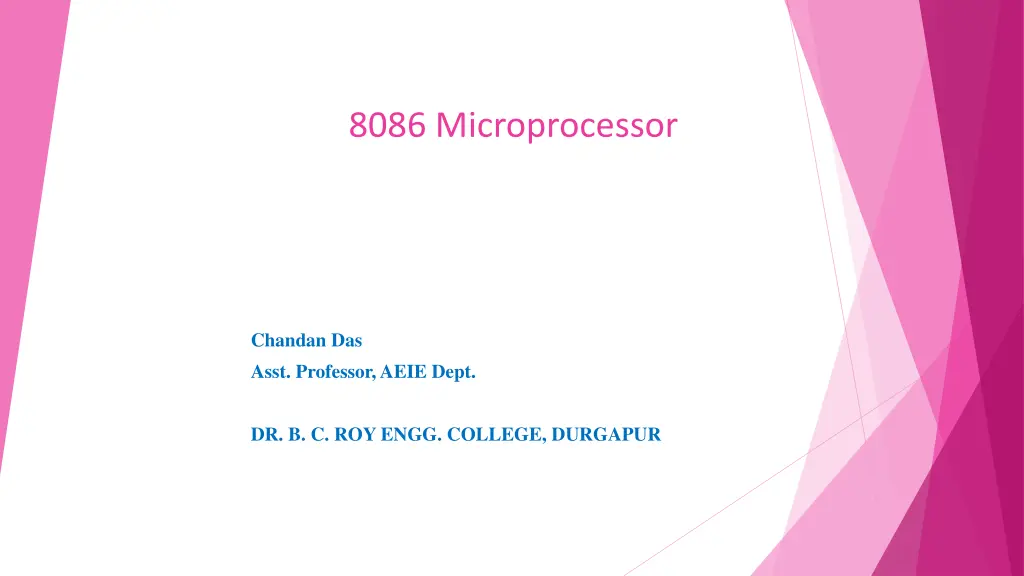
Understanding 8086 Microprocessor and Its Generations
Explore the functionality of the 8086 microprocessor, its various generations, and the evolution of microprocessor technology from PMOS to HCMOS. Learn about the key features like memory space, addressing modes, interrupt handling, and more.
Uploaded on | 0 Views
Download Presentation

Please find below an Image/Link to download the presentation.
The content on the website is provided AS IS for your information and personal use only. It may not be sold, licensed, or shared on other websites without obtaining consent from the author. If you encounter any issues during the download, it is possible that the publisher has removed the file from their server.
You are allowed to download the files provided on this website for personal or commercial use, subject to the condition that they are used lawfully. All files are the property of their respective owners.
The content on the website is provided AS IS for your information and personal use only. It may not be sold, licensed, or shared on other websites without obtaining consent from the author.
E N D
Presentation Transcript
8086 Microprocessor Chandan Das Asst. Professor, AEIE Dept. DR. B. C. ROY ENGG. COLLEGE, DURGAPUR
Microprocessor Program controlled semiconductor device (IC) which fetches (from memory), decodes and executes instructions. It is used as CPU (Central Processing Unit) in computers. Chandan Das/8086 p 3
Fifth Generation Pentium Microprocessor Fourth Generation During 1980s Low power version of HMOS technology (HCMOS) 32 bit processors Physical memory space 224 bytes = 16 Mb Virtual memory space 240 bytes = 1 Tb Floating point hardware Supports increased number of addressing modes Third Generation During 1978 HMOS technology Faster speed, Higher packing density 16 bit processors 40/ 48/ 64 pins Easier to program Dynamically relatable programs Processor has multiply/ divide arithmetic Intel 80386 hardware More powerful interrupt handling capabilities Second Generation During 1973 NMOS technology Faster speed, Higher density, Compatible with TTL 4 / 8/ 16 bit processors 40 pins Ability to address large memory spaces and I/O ports Greater number of levels of subroutine nesting Better interrupt handling capabilities Flexible I/O port addressing Intel 8086 (16 bit processor) First Generation Between 1971 1973 PMOS technology, non compatible with TTL 4 bit processors 16 pins 8 and 16 bit processors 40 pins Due to limitations of pins, signals are Chandan Das/8086 p 4 Intel 8085 (8 bit processor) multiplexed
Functional blocks Microprocessor Various conditions of the results are stored as status bits called flags in flag register Computational Unit; performs arithmetic and logic operations Internal storage of data Register array or internal memory Data Bus ALU Generates address instructions fetched memory through address bus to the memory the the be the send Instruction decoding unit of to Flag Register from and Timing and control unit PC/ IP Address Bus Control Bus Generates control signals for internal and external operations microprocessor Decodes information to the timing and control unit instructions; sends Chandan Das/8086 p 5 of the
8086 Microprocessor Overview First 16- bit processor released by INTEL in the year 1978 Originally HMOS, now manufactured using HMOS III technique Approximately 29, 000 transistors, 40 pin DIP, 5V supply Does not have internal clock; external asymmetric clock source with 33% duty cycle 20-bit address to access memory address up to 220 = 1 megabytes of memory space. can Chandan Das/8086 p 6
8086 Microprocessor Pins and Signals Common signals AD0-AD15 (Bidirectional) Address/Data bus Low multiplexed with data. order address bus; these are When AD lines are used to transmit memory address the symbol A is used instead of AD, for example A0-A15. When data are transmitted over AD lines the symbol D is used in place of AD, for example D0-D7, D8-D15 or D0-D15. A16/S3, A17/S4, A18/S5, A19/S6 High order address bus. These are multiplexed with status signals Chandan Das/8086 p 8
8086 Microprocessor Pins and Signals Common signals BHE (Active Low)/S7 (Output) Bus High Enable/Status It is used to enable data onto the most significant half of data bus, D8-D15. 8-bit device connected to upper half of the data bus use BHE (Active Low) signal. It is multiplexed with status signal S7. MN/ MX MINIMUM / MAXIMUM This pin signal indicates what mode the processor is to operate in. RD (Read) (Active Low) The signal is used for read operation. It is an output signal. It is active when low. Chandan Das/8086 p 9
8086 Microprocessor Pins and Signals Common signals READY This is the acknowledgement from the slow device or memory that they have completed the data transfer. The signal made available by the devices is synchronized by the 8284A clock generator to provide ready input to the 8086. Chandan Das/8086 p 10 The signal is active high.
8086 Microprocessor Pins and Signals Common signals RESET (Input) Causes the processor to immediately terminate its present activity. The signal must be active HIGH for at least four clock cycles. CLK The clock input provides the basic timing for processor operation and bus control activity. Its an asymmetric square wave with 33% duty cycle. INTR Interrupt Request This is a triggered input. This is sampled during the last clock cycles of each instruction to determine the availability of the request. If any interrupt request is pending, the processor interrupt acknowledge cycle. enters the Chandan Das/8086 p 11 This signal is active high and internally synchronized.
8086 Microprocessor Pins and Signals Min/ Max Pins The 8086 microprocessor can work in two modes of operations : Minimum mode and Maximum mode. In the minimum mode of operation the microprocessor do not associate with any co-processors and can not be used for multiprocessor systems. In the maximum mode the 8086 can work in multi-processor configuration. or co-processor Minimum or maximum mode operations are decided by the pin MN/ MX(Active low). When this pin is high 8086 operates in minimum mode otherwise it operates in Maximum mode. Chandan Das/8086 p 12
8086 Microprocessor Pins and Signals Minimum mode signals (Data Transmit/ Receive) Output signal from the processor to control the direction of data flow through the data transceivers (Data Enable) Output signal from the processor used as out put enable for the transceivers ALE (Address Latch Enable) Used to demultiplex the address and data lines using external latches Used to differentiate memory access and I/O access. For memory reference instructions, it is high. For IN and OUT instructions, it is low. Write control signal; asserted low Whenever processor writes data to memory or I/O port (Interrupt Acknowledge) When the interrupt request is accepted by the processor, the output is low on this line. Chandan Das/8086 p 13
8086 Microprocessor Pins and Signals Minimum mode signals HOLD Input signal to the processor form the bus masters as a request to grant the control of the bus. Usually used by the DMA controller to get the control of the bus. HLDA (Hold Acknowledge) Acknowledge signal by the processor to the bus master requesting the control of the bus through HOLD. The acknowledge is asserted high, when the processor accepts HOLD. Chandan Das/8086 p 14
8086 Microprocessor Pins and Signals Maximum mode signals Status signals; used by the 8086 bus controller to generate bus timing and control signals. These are decoded as shown. Chandan Das/8086 p 15
8086 Microprocessor Pins and Signals Maximum mode signals (Queue Status) The processor provides the status of queue in these lines. The queue status can be used by external device to track the internal status of the queue in 8086. The output on QS0 and QS1 can be interpreted as shown in the table. Chandan Das/8086 p 16
8086 Microprocessor Pins and Signals Maximum mode signals Chandan Das/8086 p 17



